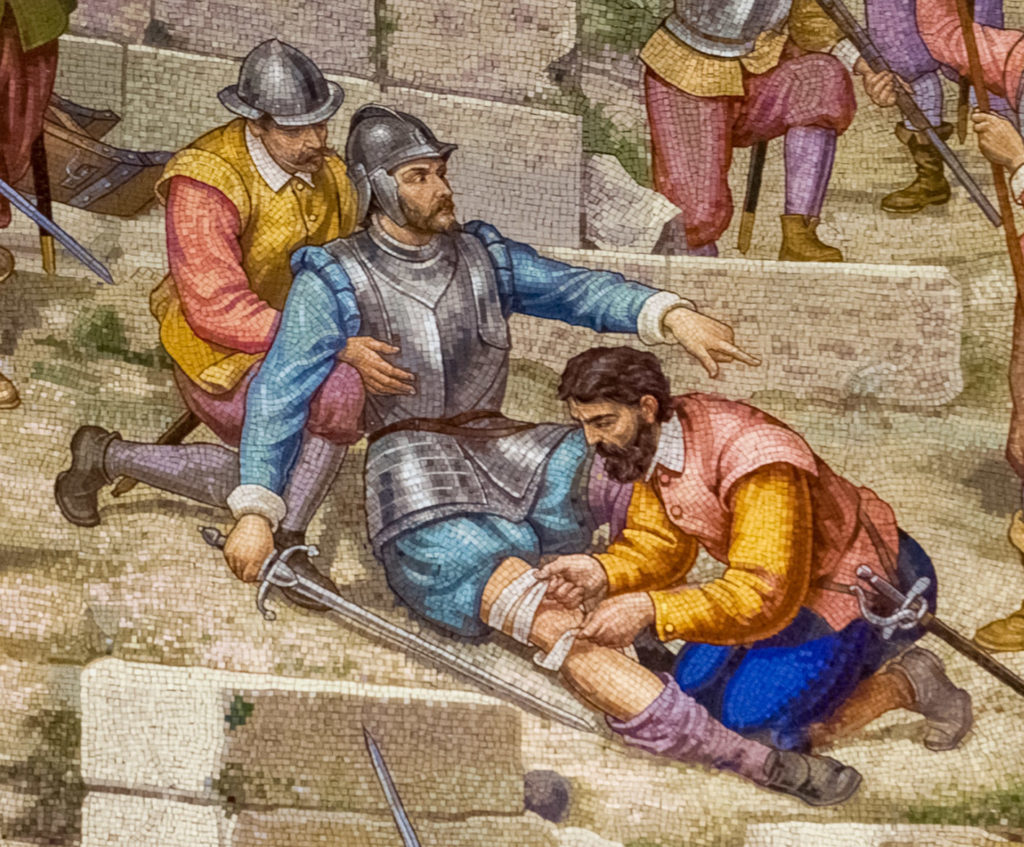Five Hundred Years After the Cannonball Struck | April 24, 2021 Essay

When you enter the Church of Saint Ignatius Loyola for the first time, your eyes are drawn to the sanctuary: the altar, the tabernacle, and the three large murals in the apse. The altar and tabernacle need no introduction or explanation, but many newcomers are curious about the scenes represented in the colorful paintings. Who are these people—soldiers, cardinals, Swiss Guards, a Pope—and what are they doing?
They commemorate moments in the life of St. Ignatius (1491–1556) and the religious order he founded. The mural on the left depicts the wounding of Inigo (later Ignatius) de Loyola in the Battle of Pamplona—the “happy fault” of the saint’s youth that was the occasion for his long recovery and conversion to serve Christ as his new Lord. The mural on the right portrays a scene set in 1540: St. Ignatius and three of his companions kneel before Pope Paul III begging approval of the rule for the religious order they wish to found—the Society of Jesus. The central mural depicts the Apotheosis of St. Ignatius—the glorification of Ignatius at the time of his canonization.
It is the first mural, the one on the left, that I would like to call your attention to today. (See the Walking Tour Guide on our website: https://drive.google.com/file/d/1x0glQWHMBlwpC01dNZq1hvEndj5HHucR/view)
In his Autobiography, dictated a year before the saint’s death to the Portuguese Jesuit Gonçalves da Câmara, St. Ignatius recalls the Battle of Pamplona this way (he speaks of himself throughout in the third person):
“He was in a fortress under attack by the French, and while everyone else clearly saw that they could not defend themselves and thought that they should surrender to save their lives, he offered so many reasons to the fortress’ commander that he talked him into defending it. Though this was contrary to the opinion of all the other knights, still each drew encouragement from his firmness and fearlessness. When the day of the expected assault came, he made his confession to one of his comrades in arms. After the attack had lasted a good while, a cannonball hit him in a leg, shattering it completely, and since the ball passed between both legs the other one was likewise severely wounded” (1:1).
The Battle of Pamplona was the event that changed the course of Ignatius’ life, the “happy fault” that led to his conversion when he decided to put down the trappings of worldly chivalry and serve only Christ as his sovereign Lord.
That fateful injury happened on the 20th of May in the Year of Our Lord 1521. Five hundred years later, our parish community will join Jesuits around the world to commemorate, celebrate, and recommit ourselves to the Ignatian pilgrimage of discernment, service, and praise for the Greater Glory of God.
On 20 May 2021, the Society of Jesus and the Ignatian family will start the worldwide celebration of an Ignatian Year. We will be celebrating the 500th anniversary of the cannonball injury St. Ignatius experienced while defending Pamplona. It started a process of conversion, which led Ignatius to have bigger dreams, no longer centered on himself, but rather on God. It helped St. Ignatius to “See all things new in Christ” (the motto of the Ignatian Year), which is why the theme of this year is ‘conversion’.
The Jesuit Superior General, Fr. Arturo Sosa, S.J., in his letter announcing the Ignatian Year, writes, “For Ignatius, a life of poverty was an expression of intimacy with Jesus, the Lord. More than words, his poverty was a sign of his interior transformation, of his growing vulnerability before the Lord, of his radical indifference to preparing himself to follow God’s will, of his sense that everything came down from above as a gift.”
How might the cannonballs in your life be shattering obstacles that stand between you and God? How might these cannonballs be showing you the way of Christ, the way of simplicity and obedience, that way that embraces poverty, humility, and generous love?
God continues to invite each of us into a deepening relationship, to ongoing conversion. We believe that by embracing this invitation, we embrace our God who calls us to act in new, bold ways that reconcile our world, bringing about justice, peace, and compassion. For this Ignatian Year, we ask for the grace to see all things new in Christ.
– Michael Hilbert, S.J., Associate Pastor
